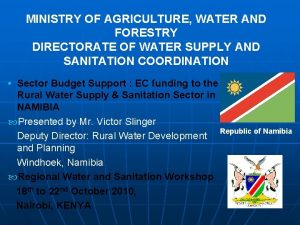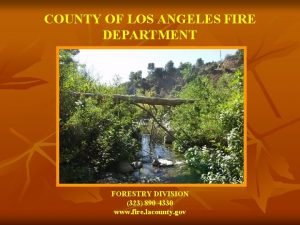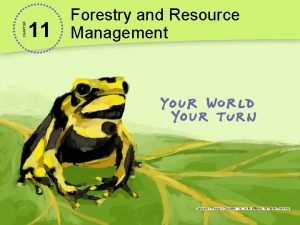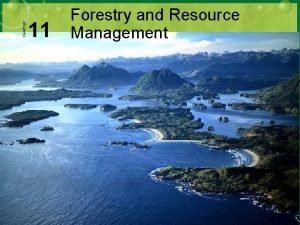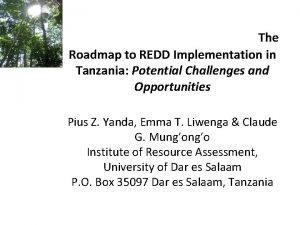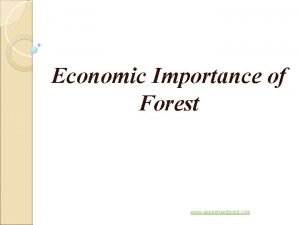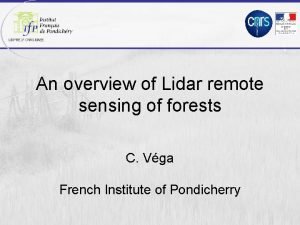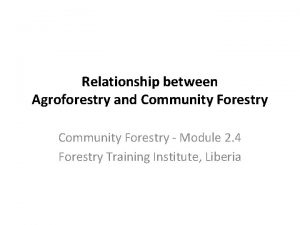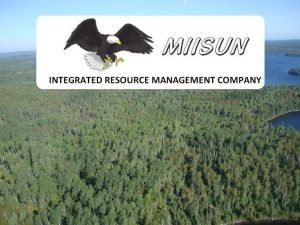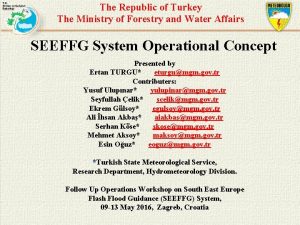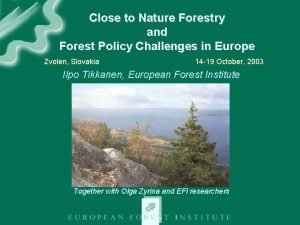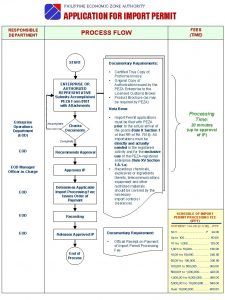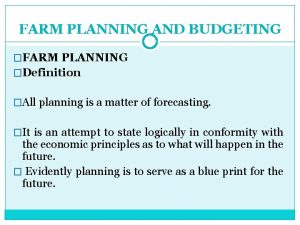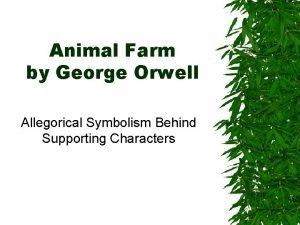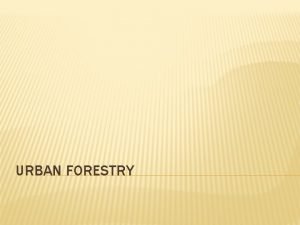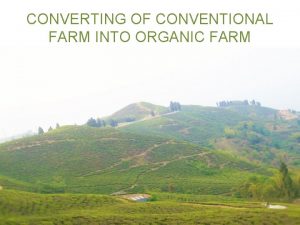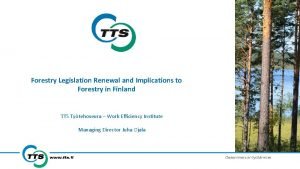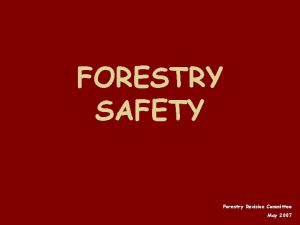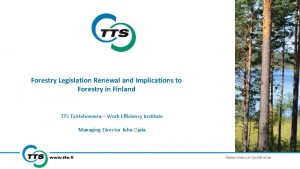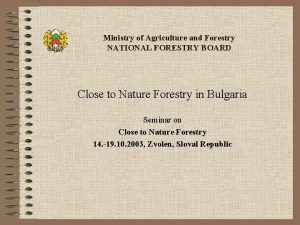FARM FORESTRY Farm Forestry came into common use

































- Slides: 33

FARM FORESTRY • ‘Farm Forestry’ came into common use in Australia in the early and mid-1990 s üAt the time, there was a desire to differentiate the practice of growing commercial trees on farms from the popular image of ‘plantations’ as being large-scale industrial ‘wall-to-wall’ plantings

FARM FORESTRY • The incorporation of productive tree growing into farming systems üImproves agricultural production by providing shelter for stock and crop üProvides substantial environmental benefits such as water table and salinity reduction (National Farm Program – Australian Government funding program 1995 -2000)

Various Concepts of Farm Forestry q. Farm forestry differs from industrial-scale forestry in that: üSmaller planting scale üSite fertility can sometimes be higher due to fertilization/land üLarger proportion of edge trees and ongoing interaction between trees and agricultural uses üTree spacing (Lott, Keenan and Lewty, 1998) q“A major criticism of the approach taken by state forest agencies to promoting private forestry, especially to farmers and other smaller growers, was of the implicit assumption that farm forestry should look just like conventional industrial plantation forestry. ” (Donaldson 1998)

Various Concepts of Farm Forestry q. Byron and Boutland (1987) noted that farm forestry was more than forestry on farms for industrial wood production” (Donaldson 1998) q“Industrial plantation monocultures have traditionally been established for the singular, legitimate goal of maximizing wood fiber production for industrial use, while it is possible to conceive of farm forestry as a kind of subset of plantation forestry, with many similarities, the differences are still substantial. ” (Alexandra and Hall 1998)

Farm Forestry: How is it different? 1. Farm forestry is not about finding farmland that is appropriate for conventional forestry plantations rather, is about the development of forestry opportunities, appropriate for farmers 2. Farm forestry is not about getting farmers to hand over their land to foresters rather, is about foresters handing over their knowledge, skills and tools for farmers 3. Farm forestry is not about more people and land supporting forestry rather, is about forestry supporting more people and more land

The main organizations and groups contributing to the development of Farm Forestry

FARM FORESTRY IN PAKISTAN: AN EVALUATION OF USAID ASSISTANCE October 1992, A. I. D. 's Center for Development Information and Evaluation (CDIE) sent a team to Pakistan to conduct an evaluation of the Pakistan farm forestry program • The evaluation team found that the farm forestry model has several important features: i. Uses private sector profit incentives as an engine to sustain its activities ii. Employs an emerging partnership between the Government and independent farmers to accomplish its objectives iii. Introduces basic, low-cost technologies with quick and visible pay-offs to attract and hold the interest of participants iv. Produces environmental benefits that help the entire country

LESSONS LEARNED q. Markets supply powerful forces capable of driving individual and institutional participation in farm forestry programs q. Encouraging tree planting on private land is an effective strategy when it capitalizes on existing conditions of land tree tenure security q. Farm forestry "sells" best when participants have access to low-cost technologies with reasonable pay-back periods q. Flexible project design permits program managers to respond effectively to new conditions and opportunities


Farm Profit and Farm Profitability What is a Farm Profit? üWhen operating costs and depreciations are subtracted from the annual farm income, result is the net farm profit. What is Farm Profitability? üProfitability is the state of mind in which a farm manager carefully controls every aspect of the operation to make the most profitable use of the resource available to farm business.

Assessing Farm Profitability 1. Cash Farm Income üIncome statement üList of sources and values of cash farm income üIncome received from custom work 2. Cash Operating Expense üOperations on farm business üFixed cash expenses (tax, insurance etc. )

Assessing Farm Profitability 3. Inventory Changes üA problem arises when inventories of crops, market livestock and other items are higher or lower at the end of accounting period than at the beginning üFarm income is either understated or overstated 4. Depreciation and other farm capital üCalculated by subtracting beginning inventories and capital purchase from each asset category from the ending inventories and capital sales q. Accrual income statement will give a picture of farm profit for the accounting period

Assessing the Financial Viability of Farm Forestry • Financial Module should be designed: üTo aid in the understanding of the concepts and techniques used to assess financial viability of farm forestry üTo develop basis computer skills in assessing the financial viability of farm forestry üTo evaluate net present value and internal rate of return


Economic Analysis • The data entry and financial analysis procedures are set out to be followed step by step to derive financial performance criteria, using the spreadsheet package Excel and calculate: üBenefit-cost Ratio üNet present value (NPV) üInternal rate of return (IRR) üSensitivity Analysis

BENEFIT-COST RATIO ANALYSIS •

NET PRESENT VALUE (NPV) • The total sum of all discounted prices of all cash flow of an investment is called net present value. • It is calculated by following formula :

INTERNAL RATE OF RETURN (IRR) • The rate of interest which makes the net present value equal to zero is called internal rate of return. • Given formula was used to analyze internal rate of return :

SENSITIVITY ANALYSIS • In sensitivity analysis the analyst checks the results of economic analysis conducting the effects of changes in the value of key variables as follows: üOutput prices remain same while input prices increased to 10% from the current input cost. üInput prices remain constant while output prices decreased by 10% from current output value.

MAXIMIZING THE EFFECTIVENESS OF FARM FORESTRY PROGRAMMES I. Role of Forest Department II. Local Organization III. Extension Efforts IV. Public Information and Program Promotion V. Seedling Distribution Programs VI. Finding Ways of Reducing Risk VII. Credit Schemes for Tree Growing VIII. Market Support Measures IX. Cash Incentives

Role of Forest Department • New goals forestry also require introducing new systems of professional education for both forestry officers and extension personnel In Pakistan, for example, farmers were reluctant to become involved in a farm forestry programs because the Forest Department was viewed with suspicion and distrust. When the project was initiated, over 50, 000 forest offences were pending in the courts, which meant that one out of six families was involved in disputes with the Forest Department (Cernea, 1981) • It is crucial that forestry departments assign qualified men and women foresters, social scientists and others to implement rural forestry programs

Local Organization • Lack of local organizations is the chief barrier to effective rural development • The types of local institutions that have filled this essential role have often been informal • Some were formed at the initiative of groups within communities or villages that have common interests in the use of tree resources and felt the need for some kind of institutional framework (Chandrasekharan, 1983)

Extension Efforts • Extension is a process through which people become familiar with new knowledge and skills of direct relevance to their lives, and through which government support services can learn about local priorities and needs. q. Extension must follow the strategy: üFirst identifying the real problems and their causes üSelecting those problems which can in some way be addressed by information üDesign ways to get that information to the right person in an effective manner

Qualities of an Extension Worker q. Extension worker must have: üListening skills üSense that they can learn from residents information needed to make them more capable as extension workers üTrained as generalists üFamiliar with technical and social issues üAble to recognize when his own knowledge is inadequate and call on more qualified experts.

Public Information and Program Promotion • Tackling and provision of information can be fairly straightforward through publicity and promotional activities • Means for spreading such information are as diverse • Includes: üPromotional sticker/Posters/newspaper advertisements üMessages on billboards/Booklets üStory tellers or singers üPuppet theatres/film strips/movies/radio üTree-planting festivals üNational campaigns/political pronouncements v The effect of these types of activities can be difficult to gauge, but active program promotion can be helpful

Seedling Distribution Programs • Distributing the seedlings free or at a subsidized cost • After popularity of such programs, there should be no need for such incentives • Continued subsidized seedling distribution serves no particularly useful function and will only inhibit farmers from establishing their own nurseries • Surveys can establish the desirability of particular types of trees • Monitoring and evaluation is an essential tool

Finding Ways of Reducing Risk • Alternative public sector support mechanisms may be necessary to reduce the farmer’s risks • Includes: üMarketing mechanisms üPrice controls üTechnical assistance üExtension • One especially important aspect of reducing risk is the certainty that the technical alternatives being suggested will work

Credit Schemes for Tree Growing • Availability of credit on appropriate terms for smallholders to undertake farm forestry • Commercial banks are willing or flexible enough to undertake the burden of administering a program of smallholder farm forestry finance • FOR EXAMPLE: In Sudan, smallholders traditionally mortgaged their gum Arabic production to merchants in return for high interest loans to purchase subsistence commodities. As part of its farm forestry program, Government introduced regulated credit facilities to reduce the negative impacts of traditional credit schemes.

Market Support Measures • Improvements are needed in: üMarketing arrangements üTransportation infrastructure • Formalized marketing structures may help protect smaller farmers unused to commercial dealings with wood merchants and felling contractors v. Help farmers tap potentially large markets outside the immediate zone

Cash Incentives • Governments can provide incentives to the private sector to encourage development of wood-based industries • Lowering costs of tree growing can be an important way of providing incentives for smallholders

Cash Incentives • Subsidies are often a means of involving rural poor where benefits of tree planting may not seem obvious, especially where farmers must have an intermediate source of income before the trees are harvested and sold • Programs which have paid farmers to plant trees usually have other objectives but some schemes like “food for work” projects have provided a payment-in-kind for tree planting

Local Constraints to Tree Growing Cf. Burley (1982) - Economic: üsufficient land, capital and labor üBenefits of tree cultivation, both in economic and financial terms, must exceed the net benefits from alternative resource - Social/Cultural: üProductive relationships and the pattern of resource ownership should have culturally accepted strategies üAvailability of appropriate and culturally sensitive technical expertise - Environmental: üInterventions or adaptive strategies must be responsive to the water availability, temperature regimes, soil types etc.

CONCLUSION • Farm forestry is one of the solutions to overcome accelerated rate of deforestation in natural forest areas • There is an urgent need to adopt a policy with a provision of livelihood opportunities by providing local and regional markets • In this way planting of indigenous species can also be promoted • The main help required from government is provision of proper species and facilities for irrigation • Poplar is a favored species and can be further encouraged by taking care of pest control • To avoid the pesticide associated hazard, indigenous practices may be evaluated so that there may become part of the integrated pest management
 Rime of the ancient mariner ending
Rime of the ancient mariner ending Indian farm forestry development cooperative limited
Indian farm forestry development cooperative limited Since jesus came into my heart
Since jesus came into my heart Holocaustnoun
Holocaustnoun Tending operations in forestry in hindi
Tending operations in forestry in hindi Ministry of agriculture, water and forestry directorates
Ministry of agriculture, water and forestry directorates Forestry licence viewer
Forestry licence viewer La county forestry
La county forestry Chapter 11 forestry and resource management
Chapter 11 forestry and resource management Forestry and resource management chapter 11 answers
Forestry and resource management chapter 11 answers Forestry io roadmap
Forestry io roadmap Careers related to forestry
Careers related to forestry Mendel university fees
Mendel university fees Economic importance of forest
Economic importance of forest Full waveform lidar
Full waveform lidar State and private forestry
State and private forestry Difference between agroforestry and community forestry
Difference between agroforestry and community forestry Miisun forestry
Miisun forestry Maine dept of agriculture
Maine dept of agriculture Forestry tep
Forestry tep Republic of turkey ministry of agriculture and forestry
Republic of turkey ministry of agriculture and forestry State forestry administration
State forestry administration Close-to-nature forestry
Close-to-nature forestry Peza form 8105 and 8106
Peza form 8105 and 8106 Characteristics of a farm plan
Characteristics of a farm plan Harmouns
Harmouns What does foxwood farm represent in animal farm
What does foxwood farm represent in animal farm Highest common factor of 12 and 42
Highest common factor of 12 and 42 Common anode and common cathode
Common anode and common cathode Factor tree for 72
Factor tree for 72 How to find lowest common factor
How to find lowest common factor Factors of 18
Factors of 18 Highest common factors and lowest common multiples
Highest common factors and lowest common multiples Large intestine function in digestive system
Large intestine function in digestive system





